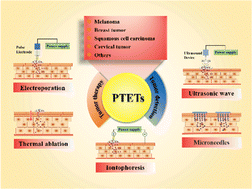Research progress of physical transdermal enhancement techniques in tumor therapy
Abstract
The advancement and popularity of transdermal drug delivery (TDD) based on the physical transdermal enhancement technique (PTET) has opened a new paradigm for local tumor treatment. The drug can be directly delivered to the tumor site through the skin, thus avoiding the toxic side effects caused by the first-pass effect and achieving high patient compliance. Further development of PTETs has provided many options for antitumor drugs and laid the foundation for future applications of wearable closed-loop targeting drug delivery systems. In this highlight, the different types of PTETs and related mechanisms, and applications of PTET-related tumor detection and therapy are highlighted. According to their type and characteristics, PTETs are categorized as follows: (1) iontophoresis, (2) electroporation, (3) ultrasound, (4) thermal ablation, and (5) microneedles. PTET-related applications in the local treatment of tumors are categorized as follows: (1) melanoma, (2) breast tumor, (3) squamous cell carcinoma, (4) cervical tumor, and (5) others. The challenges and future prospects of existing PTETs are also discussed. This highlight will provide guidance for the design of PTET-based wearable closed-loop targeting drug delivery systems and personalized therapy for tumors.



 Please wait while we load your content...
Please wait while we load your content...